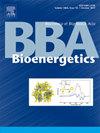Structural integrity and near-infrared absorption of the LH1 complex of Thermochromatium tepidum: Influence from the C-terminal lysine residues of LH1 α-polypeptide
IF 2.7
2区 生物学
Q2 BIOCHEMISTRY & MOLECULAR BIOLOGY
引用次数: 0
Abstract
The light-harvesting complex 1-reaction center (LH1-RC) photosystem of the thermophilic purple sulfur bacterium Thermochromatium (Tch.) tepidum exhibits a near-infrared LH1-Qy absorption band at 915 nm as regulated by binding calcium ions (Ca2+). To further explore the possible involvement of the C-terminal lysine residues of the LH1 α-polypeptide, we have genetically engineered a Rhodospirillum rubrum mutant strain to yield the site-directed modifications of the terminal α-Lys60 and α-Lys61 residues of Tch. tepidum LH1 α-polypeptide. Four of the LH1 mutants exhibit a subtle blue shift of 3 nm upon deletion or substitution of the lysine residues, however, they display over 40 nm blue shifts upon Ca2+ removal by ethylene diamine tetraacetic acid (EDTA) treatment. Spectral properties of native Tch. tepidum LH1-RC, the LH1-only, and the mutant LH1-only complexes are compared on a structural basis, which allows us to conclude that the C-terminal lysine residues and the Ca2+ binding synergistically affect the structural integrity and the LH1-Qy spectral shift. This work demonstrates a methodology for the genetic manipulation of photosynthetic proteins lacking mutagenesis information, and may shed light on understanding the detailed structural factors involved in tuning the LH1-Qy absorption.

温染菌LH1配合物的结构完整性和近红外吸收:LH1 α-多肽c端赖氨酸残基的影响
嗜热紫色硫细菌Thermochromatium (Tch.) tepidum的集光配合物1-反应中心(LH1-RC)光系统在915 nm处表现出受钙离子(Ca2+)结合调控的近红外LH1-Qy吸收带。为了进一步探索LH1 α-多肽c端赖氨酸残基的可能参与,我们对红红螺旋菌突变株进行了基因工程改造,以获得Tch末端α-Lys60和α-Lys61残基的位点定向修饰。鳞片LH1 α-多肽。其中四个LH1突变体在赖氨酸残基缺失或取代后表现出3 nm的轻微蓝移,然而,在乙二胺四乙酸(EDTA)处理下去除Ca2+后,它们表现出超过40 nm的蓝移。天然Tch的光谱性质。在结构基础上比较了tepidum LH1-RC, LH1-only和突变体LH1-only复合物,这使我们可以得出结论,c端赖氨酸残基和Ca2+结合协同影响结构完整性和LH1-Qy谱移。这项工作展示了一种缺乏突变信息的光合蛋白的遗传操作方法,并可能有助于理解调节LH1-Qy吸收的详细结构因素。
本文章由计算机程序翻译,如有差异,请以英文原文为准。
求助全文
约1分钟内获得全文
求助全文
来源期刊

Biochimica et Biophysica Acta-Bioenergetics
生物-生化与分子生物学
CiteScore
9.50
自引率
7.00%
发文量
363
审稿时长
92 days
期刊介绍:
BBA Bioenergetics covers the area of biological membranes involved in energy transfer and conversion. In particular, it focuses on the structures obtained by X-ray crystallography and other approaches, and molecular mechanisms of the components of photosynthesis, mitochondrial and bacterial respiration, oxidative phosphorylation, motility and transport. It spans applications of structural biology, molecular modeling, spectroscopy and biophysics in these systems, through bioenergetic aspects of mitochondrial biology including biomedicine aspects of energy metabolism in mitochondrial disorders, neurodegenerative diseases like Parkinson''s and Alzheimer''s, aging, diabetes and even cancer.
 求助内容:
求助内容: 应助结果提醒方式:
应助结果提醒方式:


